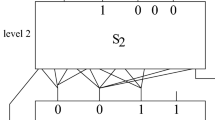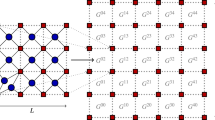Abstract
Based on the ε- and Δ-classes of the polynomial-time hierarchy, Schöning [S1], [S3]introduced low and high hierarchies within NP Several classes of sets have been located in the bottom few levels of these hierarchies [S1], [S3], [KS], [BB], [BS2], [AH]. Most results placing sets in the Δ-levels of the low hierarchy are related to sparse sets, and the proof techniques employed involve deterministic enumeration of sparse sets. Balcàzaret al. [BBS]and Allender and Hemachandra [AH] introduced extended low hierarchies, involving sets outside of NP, based on the ε- and gD-classes of the polynomial-time hierarchy. Several classes of sets have been located in the Δ-levels of these hierarchies as well, and once again most such results involve sparse sets.
In this paper we introduce a refinement of the low and high hierarchies and of the extended low hierarchies. Our refinement is based on the Θ-classes of the polynomial-time hierarchy. We show that almost all of the classes of sets that are known to belong to the Δ-levels of the low and extended low hierarchies actually belong to the newly defined Θ-levels of these hierarchies. Our proofs use Kadin's [K1]technique of computing the census of a sparse set first, followed by a nondeterministic enumeration of the set. This leads to the sharper lowness results.
We also consider the optimality of these new lowness results. For sets in the Θ-levels of the low hierarchy we have oracle results indicating that substantially stronger results are not possible through use of Kadin's technique. For sets in the Θ-classes of the extended low hierarchy we have tight absolute lower bounds; that is, lower bounds without oracles. These bounds are slightly stronger than similar bounds appearing in [AH].
Similar content being viewed by others
References
D. Angluin. On counting problems and the polynomial-time hierarchy.Theoret. Comput. Sci., 12:161–173, 1980.
E. Allender and L. Hemachandra. Lower bounds for the low hierarchy.J. Assoc. Comput. Mech, 39(1):234–251, 1992.
V Arvind, J. Kobler, and M. Mundhenk. Lowness and the Complexity of Sparse and Tally Descriptions. Technical Report 92-04, Ulmer Informatik-Berichte, 1992.
J. Balcazar and R. Book. Sets with small generalized Kolmogorov complexity.Acta Inform., 23:679–688, 1986.
J. Balcá→, R. Book, and U. Schöning. Sparse sets, lowness, and highness.SIAMJ. Comput., 15:739–747, 1986.
J. Balcázar, J. Diaz, and J. Gabarró.Structural Complexity I. Springer-Verlag, Berlin, 1988.
T. Baker, J. Gill, and R. Solovay. Relativizations of the P=? NP question.SIAMJ. Comput., 4(4):431–441, 1975.
R. Book and K. Ko. On sets reducible to sparse sets.SIAM J. Comput., 17:903–919, 1988.
R. Book, T. Long, and A. Selman. Quantitative relativizations of complexity classes.SIAMJ. Comput., 13(3):461–487, 1984.
T. Baker and A. Selman. A second step toward the polynomial hierarchy.Theoret Comput. Sci, 8:177–187, 1979.
J. Balcazar and U. Schöning. Logarithmic advice classes. Technical Report LSI-88-12, Universitat Politecnica Catalunyu, 1988. To appear inTheoret. Comput. Sci.
R. Book and S. Tang. A note on sparse sets and the polynomial-time hierarchy.Inform. Process. Lett., 33(3):141–143, 1989.
J. Castro and C. Seara. The θ-Operator and the Low Hierarchy. Technical Report LSI-92-16-R, Universitat Politécnica de Catalunya, 1992.
J. Kadin. pNP[logn] and sparse Turing-complete sets for NP.Proc. Second Annual Conference on Structures in Complexity, pp. 33–40, 1987.
J. Kadin. Restricted Turing Reducibilities and the Structure of the Polynomial Time Hierarchy. Ph.D. thesis, Cornell University, 1988.
K. Ko. Applying techniques of discrete complexity theory to numerical computation. In Ronald V Book, editor,Studies in Complexity Theory, pp. 1–62. Pitman, London, 1986.
J. Köbler. Locating P/poly Optimally in the Extended Low Hierarchy. Technical Report 92-05, Ulmer Informatik-Berichte, 1992.
K. Ko and U. Schöning. On circuit-size and the low hierarchy in NP.SIAM J. Comput., 14(1):41–51, 1985.
A. Lozano and J. Toran. Self-reducible sets of small density.Math. Systems Theory, 24:83–100, 1991.
S. Mahaney. Sparse complete sets for NP: solution of a conjecture of Berman and Hartmanis.J. Comput. System Sci., 25:130–143, 1982.
A. Meyer and M. Paterson. With What Frequency Are Apparently Intractable Problems Difficult? technical Report MIT/LCS/TM-126, M.I.T., 1979.
U. Schöning. A low and a high hierarchy within NP.J. Comput. System Sci., 27:14–28, 1983.
U. Schöning. Complete sets and closeness to complexity classes.Math. Systems Theory, 19:29–41, 1986.
U. Schöning.Complexity and Structure. Lecture Notes in Computer Science, Vol. 211. Springer-Verlag, Berlin, 1986.
S. Tang and R. Book. Separating polynomial-time taring and truth-table degrees of tally sets.Proc. 15th Colloquium on Automata, Languages, and Programming, pp. 591–599. Lecture Notes in Computer Science, Vol. 317. Springer-Verlag, Berlin, 1988.
C. Wrathall. Complete sets and the polynomial hierarchy.Theoret. Comput. Sci., 3:23–33, 1976.
Author information
Authors and Affiliations
Additional information
This work was supported in part by NSF Grant CCR-8909071. The second author's current address is Networking Software Division, IBM Research, Triangle Park, NC 27709, USA.
Rights and permissions
About this article
Cite this article
Long, T.J., Sheu, M.J. A refinement of the low and high hierarchies. Math. Systems Theory 28, 299–327 (1995). https://doi.org/10.1007/BF01185399
Received:
Revised:
Accepted:
Issue Date:
DOI: https://doi.org/10.1007/BF01185399




